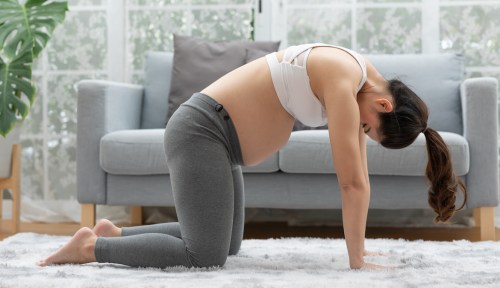Our editors independently select these products. Making a purchase through our links may earn Well+Good a commission
Pregnancy can be quite a physical journey. As your body undergoes monumental changes to accommodate a growing baby, unfortunately, muscle aches seem to be a nearly inextricable part of the process—particularly lower back pain.
Experts in This Article
certified yoga and Pilates instructor and chief training officer at Pvolve
“Carrying around extra weight puts added stress on the muscles of our low back, especially when you consider that a lot of that extra weight is carried in the front [of the] body,” explains Antonietta Vicario, a certified yoga and Pilates instructor and the vice president of talent and training at P.volve, a physical therapy-inspired functional fitness method for women. “During pregnancy, it is common to have more of an arch to the lower back, called lordosis, caused by the shift in the center of gravity. The extra weight and extra compression of the lordotic curve are a recipe for low back pain.”
Fortunately, stretching can be a safe, natural, and effective way to relieve this discomfort. Vicario walked us through four of the most effective moves that are safe for any trimester of pregnancy.
Cat stretch
This stretch helps release tension in the lower back because it provides the opposite movement of lordosis, the typical sway back posture often present during pregnancy (especially as the baby grows). That arching of the lower spine could be putting extra strain and tension on the vertebrae, notes Vicario. She adds that cat stretch “is also a great movement to open up between the shoulder blades, another common area of tension.”
- Get down on your hands and knees in a tabletop position with a flat back and your core engaged.
- Exhale and contract through your abdominals as you round your upper spine towards the ceiling, dropping the head and tailbone toward the floor.
- Continue for as many reps and at a speed that works best to relieve tightness in your lower back.
Wide child’s pose
“A wide child’s pose lengthens the posterior chain of the body to stretch out the lower back while also being incredibly restful,” shares Vicario. She suggests closing your eyes and breathing into the lower back to augment the benefit of this stretch. “Slow, deep breaths stimulate your parasympathetic nervous system, your ‘rest-and-digest response,’ which may lower any stress or cortisol in the body,” she explains.
- Kneel down with your big toes together, knees wide.
- Sit back on your heels and rest your chest and forehead on the floor or a pillow in front of you. Your arms should be extended straight in front of you as far as they can go. If your growing belly gets in the way, spread your knees wider to make room.
- Focus on breathing deeply, aiming to exhale longer than you inhale, which stimulates your vagus nerve: Inhale for four to six counts, and exhale for six to eight counts.
Kneeling lunge
“The lordotic curve created by a growing belly can also tax and shorten the muscles of the hip flexors,” says Vicario, who notes that opening the front of the hips with this stretch may also relieve low back pain.
- Drop down into a kneeling forward lunge with your knees bent at 90-degree angles, your torso upright and core engaged.
- Squeeze the glute on the rear leg and shift your pelvis forward while reaching overhead. One tip Vicario shares for this stretch is to focus on creating space in the front of your hip and along your lower back to reduce any tension or tightness in these areas.
- Repeat eight to 10 slow reps, and then switch sides.
Pigeon pose
Low back pain during pregnancy can also be a result of tightness from the hips, and this yoga pose for back pain can help stretch the muscles in that area. According to Vicario, “The extra weight of the baby requires that our glutes do a lot more work for locomotion, so stretching the muscles of the glutes can help relieve lower back sensitivity.”
- Sit on the floor with one leg folded as close to a 90-degree angle as possible in front of your body (sort of like a cross-legged position), and extend the other leg straight back behind you. Ensure your pelvis is both grounded and square, which may mean you need to stack pillows or towels under one hip.
- Fold your body forward until you feel a comfortable stretch on the side of the glutes. Inhale and exhale slowly for a minimum of 20 to 45 seconds to allow for the muscles to release.
- Switch legs and repeat.
Remember to breathe
With all of these stretches, Vicario says that slow, deep breathing is paramount. “One of our biggest rules of thumb at P.volve is that when moving throughout pregnancy, be sure to breathe to create stability,” she explains. “We always cue for you to ‘blow before you go,’ as that exhale creates muscular support during a time where you may feel more unstable in movement due to the shift in one’s center of gravity.”
Vicario also notes that deep breathing works to calm and restore the body. “Sometimes, our stress carries over to tightness in the body, so by prioritizing breathwork within a stretch for the lower back, you are doing two for one,” says Vicario. “While this time of life is incredibly exciting, it can also be busy, and sometimes stressful, especially as one’s delivery date nears.”
Oh hi! You look like someone who loves free workouts, discounts for cutting-edge wellness brands, and exclusive Well+Good content. Sign up for Well+, our online community of wellness insiders, and unlock your rewards instantly.
Sign Up for Our Daily Newsletter
Get all the latest in wellness, trends, food, fitness, beauty, and more delivered right to your inbox.
Got it, you've been added to our email list.











